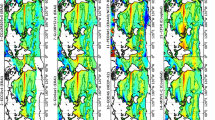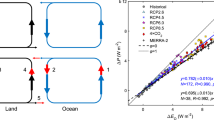Abstract
We have performed experiments using an ocean model to study the sensitivity of tropical Pacific Ocean to variations in precipitation induced freshwater fluxes. Variations in these fluxes arise from natural causes on all time scales. In addition, estimates of these fluxes are uncertain because of differences among measurement techniques. The model used is a quasi-isopycnal model, covering the Pacific from 40 °S to 40 °N. The surface forcing is constructed from observed wind stress, evaporation, precipitation, and sea surface temperature (SST) fields. The heat flux is produced with an iterative technique so as to maintain the model close to the observed climatology, but with only a weak damping to that climatology. Climatological estimates of evaporation are combined with various estimates of precipitation to determine the net surface freshwater flux. Results indicate that increased freshwater input decreases salinity as expected, but increases temperatures in the upper ocean. Using the freshwater flux estimated from the Microwave Sounding Unit leads to a warming of up to 0.6 °C in the western Pacific over a case with zero net freshwater flux. SST is sensitive to the discrepancies among different precipitation observations, with root-mean-square differences in SST on the order of 0.2–0.3 °C. The change in SST is more pronounced in the eastern Pacific, with difference of over 1 °C found among the various precipitation products. Interannual variation in precipitation during El Niño events leads to increased warming. During the winter of 1982–83, freshwater flux accounts for about 0.4 °C (approximately 10–15% of the maximum warming) of the surface warming in the central-eastern Pacific. Thus, the error of SST caused by the discrepancies in precipitation products is more than half of the SST anomaly produced by the interannual variability of observed precipitation. Further experiments, in which freshwater flux anomalies are imposed in the western, central, and eastern Pacific, show that the influence of net freshwater flux is also spatially dependent. The imposition of freshwater flux in the far western Pacific leads to a trapping of salinity anomalies to the surface layers near the equator. An identical flux imposed in the central Pacific produces deeper and off-equatorial salinity anomalies. The contrast between these two simulations is consistent with other simulations of the western Pacific barrier layer formation.
Similar content being viewed by others
Author information
Authors and Affiliations
Additional information
Received: 10 July 1998 / Accepted: 2 February 1999
Rights and permissions
About this article
Cite this article
Yang, S., Lau, KM. & Schopf, P. Sensitivity of the tropical Pacific Ocean to precipitation-induced freshwater flux. Climate Dynamics 15, 737–750 (1999). https://doi.org/10.1007/s003820050313
Issue Date:
DOI: https://doi.org/10.1007/s003820050313




